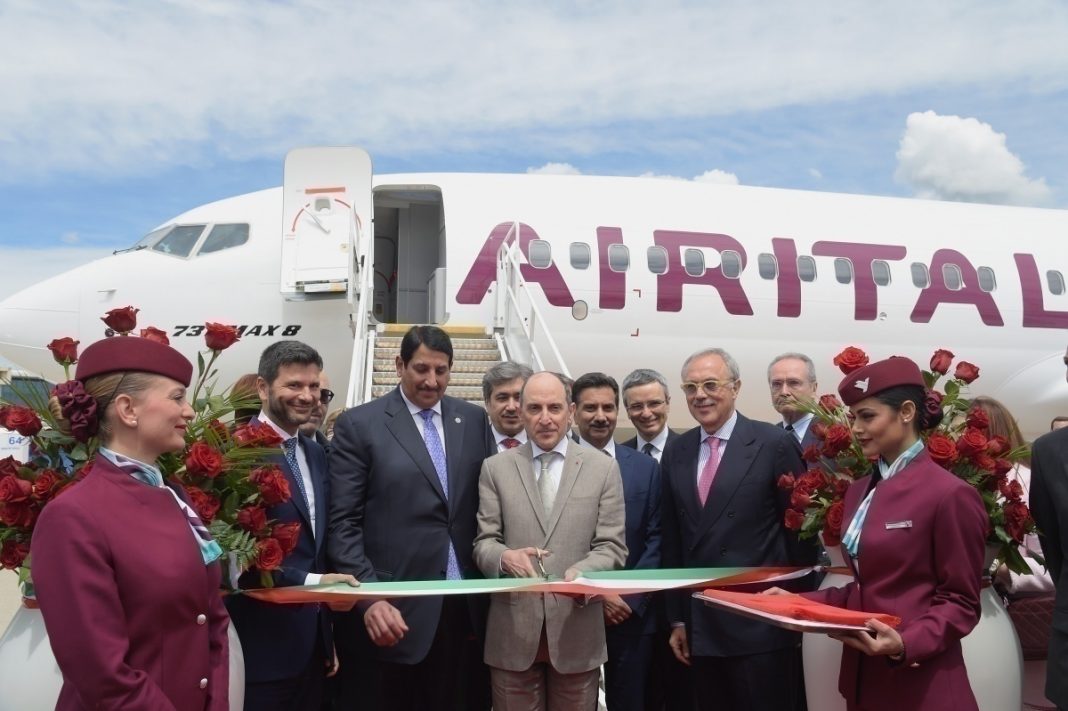In its current form, Air Italy was founded just under two years ago in early 2018. The new airline held much promise as a rival to the incumbent legacy carrier, Alitalia. However, as of late February 2020, the airline has suspended its operations and liquidated its assets – essentially failing as a carrier. With such high hopes for the Qatar Airways-backed airline, what happened to Air Italy, and how did it fall?

Significant investment by Qatar Airways
Air Italy, as a name, started as a charter airline in 2005 and was then acquired in 2013 by the larger Italian carrier Meridiana.
Mediana, however, was founded back in the early 1960s, and it’s been through a couple of major rebrands since then. It started as Alisarda in 1963, serving several destinations in Italy and further afield in Europe from its base in Obia on the island of Sardinia.
Then, in 1991, a merger brought Alisarda together with Spanish airline Universair. Both airlines were rebranded together as Meridiana – which then acquired the small charter airline Air Italy.

In September of 2017, Qatar Airways announced that it would be buying 49% of AQA Holding – the parent company of Meridiana. Shortly after that, it was announced that Qatar Airways would merge Air Italy with the current Meridiana subsidiary under the Meridiana AOC. Just a few months later, in February of 2018, the Meridiana name vanished, and Air Italy emerged with a new brand and new strategy.
Expansions and partnerships
2019 was a year of growth and development for Air Italy – aggressively going after the competition with the signing of various agreements with other major airlines.

Since the modern Air Italy inception, it has had certain codeshare agreements with Qatar Airways. These were large for services between Doha and Rome Fiumicino, as well as Pisa, Venice, Singapore, and the Maldives. Qatar Airways flights shared with Air Italy included those between Milan and Fiumicino, Naples, Olbia, and Lamezia.
“The commencement of our partnership with Qatar Airways is good news for passengers of both airlines. Our passengers can now benefit from a new choice for visiting Doha or to reach, via Doha, the white sandy beaches of Maldives and one of the most modern and busy Asian city, such as Singapore.” -Marco Rigotti, Air Italy Deputy Executive Chairman via Airways

In August of 2019, a partnership was announced with Finnish carrier Finnair and Israeli airline El Al. For the agreement with Finnair, five Finnish destinations (Helsinki, Turku, Oulu, Kokkola, and Rovaniemi) were made accessible via Milan Malpensa. For El Al, Air Italy’s passengers traveling from the United States would be able to connect with the Israeli airline via Malpensa and book onward flights to Tel Aviv. The reciprocal agreement allowed El Al customers to choose Air Italy as their carrier to North America.
According to Planespotters.net, the airline had a fleet of 12 aircraft. Four Airbus A330s and eight Boeing 737s. This number of 737s was realistically only five, however, as three were the grounded Boeing 737 MAX. Air Italy had been expecting more of the aircraft when it was grounded. Its four Airbus A330s had come from Qatar Airways and were flying long-haul to North America.

It’s growth plans even included looking for a US carrier to partner with. Of course, it would not be successful with this search as the conflict between itself and US carriers was a defining aspect of its short-lived time as an airline…
Enemies across the ocean
The big US airlines were never fans of Air Italy. With 49% owned by Qatar Airways, American carriers considered it an extension of the Middle Eastern airline. The US carriers have firmly been against the way Middle Eastern carriers have operated – claiming that the three airlines (Qatar, Etihad, Emirates) have had an unfair advantage through tens of billions of dollars worth of government subsidies.

Air Italy strenuously denied the allegations saying at the time:
“As of [May 2019] we have a fleet of 13 aircraft, five of which are capable of operating long-haul service. While we pride ourselves on our flair and world-class service, we are puzzled (but slightly flattered) that the three very largest US carriers – which between themselves operate a fleet of more 2,500 aircraft – claim to be threatened by us.”
The fall of Air Italy
It was in early February that Air Italy announced that it would suspend operations as of the 25th of the month. Then, at a shareholder meeting on February 11th, it was decided that the airline would be liquidated following.
Qatar Airways issued a statement regarding Air Italy’s insolvency proceedings, saying that it “was ready once again to play its part in supporting the growth of the airline.” However, this would “only have been possible with the commitment of all shareholders.”

There were a few factors that led to Air Italy’s downfall. One early issue was the grounding of the Boeing 737 MAX and the inability of the new carrier to operate three MAX 8 jets that it had already taken possession of. With the jets grounded, Air Italy was forced to lease three replacement planes.
Additionally, Air Italy was operating in a highly competitive marketplace. While flag carrier Alitalia may not have been the fiercest of rivals, Air Italy would have to go up against low-cost carriers like Ryanair and easyJet in the short-haul marketplace. On the long-haul side, the airline would also have to compete with its US rivals.
Finally, the straw breaking the proverbial camel’s back was the global health crisis, which emerged through February and March. Significant travel restrictions and plummeting demand killed any remaining optimism that shareholders may have had in keeping the airline going.
Do you think there were any other factors in Air Italy’s fall? Let us know in the comments.
[ad_2]
Source link


